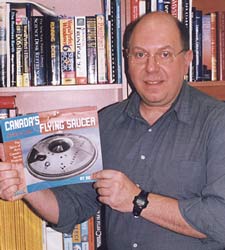
Nick Balaskas
Nick Balaskas, lab technician in the Department of Physics, Faculty of Pure and Applied Science, has an unusual hobby: searching for signs of extraterrestrials. He gets calls from the public, the media and the police force for help in investigating sightings of UFOs and claims of alien abductions.Balaskas has had substances, which people claimed were implanted by aliens, analyzed in various labs. "Once, a sliver of metal was removed from a woman who believed she had been abducted by extraterrestrials. It was surgically removed from an area where previously no wound had been visible.
"The metal was found to be iron, and investigators decided that it could have entered her body in a childhood accident. Shrapnel can move around the body and come out later far from where it entered. Still, it wasn't entirely ruled out that it could have been implanted by an extraterrestrial."
Balaskas had another item analyzed at the University of Toronto. The report revealed that its physical and chemical properties were unusual. "But, unless it's stamped 'Made on Mars' it is hard to prove it's an extraterrestrial substance," he said.
In his quest for facts about UFO phenomenon, he has checked the personal papers of researchers and examined documents at the National Archives of Ottawa and other archives, including those of scientist Omond Solandt, chancellor of the University of Toronto from 1965-1971, and founder and first Chair of the Defense Research Board. Solandt, who died in 1993, headed two Canadian government-sponsored UFO studies (Project Magnet and Project Second Storey) in close collaboration with the United States, said Balaskas. The results of these studies were never made public, and Balaskas has no explanation for the secrecy.
He is continuing his own research, ever hopeful of finding solid evidence that aliens have visited Earth.